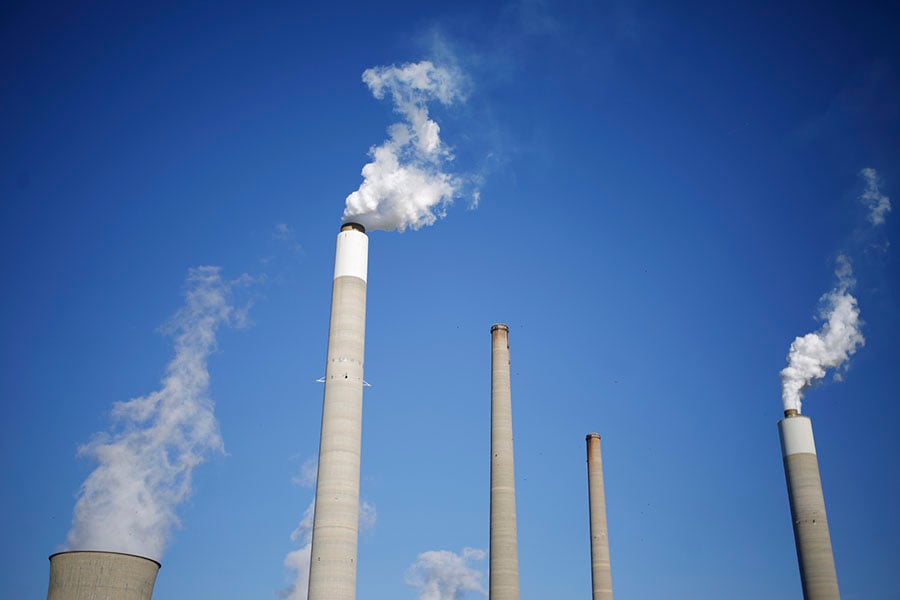

April came and went with nary a peep from the SEC about the destiny of its proposed climate disclosure rule for public companies.
The agency, which first floated the rule more than a year ago, had set a deadline of last month for publishing the final version. Now reports indicate that the regulator is now hoping to do so by this fall.
By requiring most public companies to disclose their greenhouse gas emissions, the Securities and Exchange Commission intends to bring standardization to data that are already being widely reported, albeit in inconsistent ways. However, the rule’s delay, and a big question about whether it will include all-encompassing Scope 3 emissions, has left companies with uncertainty in the meantime.
“Postponement is probably muddying the waters for businesses. They’re less certain about what it is they’ll have to do,” said Andy Garraway, global climate policy analyst at climate analytics firm Risilience. But “it doesn’t change the fundamentals of what’s coming … Businesses should really be going ahead, getting themselves familiar with what those expected provisions are.”
It is all but inevitable that the SEC will require companies to report their Scope 1 and 2 emissions, or those that they directly emit or that stem from the energy they use. But Scope 3 emissions, which pertain to everything in the supply chain and the consumers’ use of products companies sell, are still a question. Such reporting was included in the SEC’s proposal, but Scope 3 has received the most pushback from industry groups. Some have said it would be overly burdensome for businesses to measure and report, and others have said it amounts to requiring smaller, private companies to also report their emissions, as they tend to be in larger public companies’ supply chains.
SEC Chair Gary Gensler, who has made it clear that he isn’t out to make friends, has noted that most of the public feedback the agency has received is in favor of more disclosure.
As far as corporations go, there is a lot of talk about aspirations to reduce climate change. There is, however, insufficient action necessary to limit global warming to the 1.5°C goal in the Paris Agreement.
Globally, about half of public companies have made targets to reduce their carbon footprints, according to a report this week from MSCI. However, only 17% of those targets are in line with the 1.5°C goal, and 30% of such targets are for net-zero emissions, the company found. Those low figures not only hint at the risk of the world exceeding the 1.5°C mark, but they also show that companies are unprepared for voluntary and mandatory climate-disclosure standards that will take effect in various countries, according to the report.
MSCI’s Net-Zero Tracker, which provides data for asset managers and investors, “shows that public companies are projected to deplete their share of the global emissions budget for limiting temperature rise to 1.5°C by October 2026, two months sooner than MSCI previously estimated in October 2022," the report stated.
Better, more consistent climate data — as would be mandated by the SEC — could help investors understand the risks and opportunities companies face, proponents of more disclosure have said. However, in many cases investors are pushing public companies to measure their carbon data, publicly report it and come up with plans to reduce it. Such has been the case in numerous shareholder resolutions brought over the past couple of years, with activist investors prodding companies for more data — including Scope 3 emissions.
“The equation for investors is that they must address transition risks today or face severe and irreversible physical risks tomorrow, and that they have a role to play in driving the existential change required,” Sylvain Vanston, executive director of climate change investment research at MSCI, said in the company’s announcement of its findings. “Investors can use their strategic levers, including asset allocation, green investments and engagement with boards and policymakers, to help not just put companies on a net-zero path, but also encourage the regulatory changes needed to level the business playing field between.”
While some U.S. companies are fretting about having to report their climate data, those with a global presence are generally more used to supplying that information for the operations across Europe and in Japan.
“A lot of companies haven’t done this before in the States. They’ll not really know where to turn,” Garraway said.
Businesses in the U.K. are often willing to provide general guidance, he noted. There, pushback against ESG hasn’t been a phenomenon, at least not to the extent that is has become in the U.S.
“That debate doesn’t really exist over here — in the U.K. or Europe. It’s a settled issue," Garraway said. "And that has fed through to the acceptance of ESG reporting.”

Rajesh Markan earlier this year pleaded guilty to one count of criminal fraud related to his sale of fake investments to 10 clients totaling $2.9 million.

From building trust to steering through emotions and responding to client challenges, new advisors need human skills to shape the future of the advice industry.

"The outcome is correct, but it's disappointing that FINRA had ample opportunity to investigate the merits of clients' allegations in these claims, including the testimony in the three investor arbitrations with hearings," Jeff Erez, a plaintiff's attorney representing a large portion of the Stifel clients, said.

Chair also praised the passage of stablecoin legislation this week.

Maridea Wealth Management's deal in Chicago, Illinois is its first after securing a strategic investment in April.
Orion's Tom Wilson on delivering coordinated, high-touch service in a world where returns alone no longer set you apart.
Barely a decade old, registered index-linked annuities have quickly surged in popularity, thanks to their unique blend of protection and growth potential—an appealing option for investors looking to chart a steadier course through today's choppy market waters, says Myles Lambert, Brighthouse Financial.
